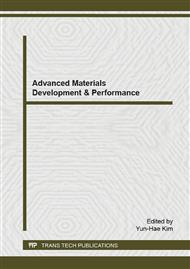p.222
p.226
p.231
p.235
p.241
p.249
p.253
p.259
p.263
Effects of Heat Annealing on the Gas Sensing Properties of Spin Coated Unsubstituted Copper Phthalocyanine Films
Abstract:
Unsubstituted copper phthalocyanine (CuPc) thin films on glass substrate were prepared using spin coating technique. The effects of heat annealing of CuPc films on the NO2 gas sensing properties were studied. The results showed that the films annealed at 150°C have highest sensitivity, highest response rate and lower response time. Sensitivity and response rate were decreased and response time was increased after annealing with temperature 200°C and above. The duration over which the films were annealed changes the gas sensing properties. Highest sensitivity, highest response rate, lower response time and highest recovery rate were observed for 2 hour (150°C) annealed films. Longer annealing time causes the decrease of sensitivity, response rate and recovery rate and increase of response time however improves recovery ratio. The heat treatment limited to the temperature of 150°C for 2 hours duration improves the sensing properties of the films. Hence heat annealed unsubstituted CuPc spin coated films can be used as nitrogen dioxide gas sensor.
Info:
Periodical:
Pages:
241-245
Citation:
Online since:
June 2015
Authors:
Price:
Сopyright:
© 2015 Trans Tech Publications Ltd. All Rights Reserved
Share:
Citation:


